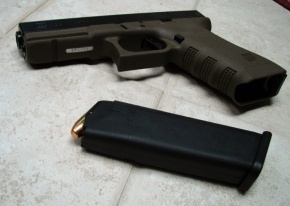Glock
The Glock handguns are in use by a majority of US and international law enforcement agencies and military personnel. Glock handguns are also very popular with civilians, especially for personal protection and practical shooting. Glock currently produces 35 models of handguns. The US-led Multi National Force-Iraq has equipped the Iraqi military and the Iraqi National Police with Glock sidearms.
Contents |
[edit] History
Founded in 1963,[1] Glock started out as a manufacturer of curtain rods before branching out into the arms industry in the 1970s, manufacturing machine gun belts, practice hand grenades, plastic magazines, field knives, and entrenching tools for the Austrian Army.[1] When, in the early 1980s, the Austrian Army requested a pistol model, Glock responded with the Glock 17, a 9 mm semi-automatic pistol. (The 17 was so-named because it was Gaston Glock's seventeenth patent.) The Austrian Army adopted the Glock 17 in 1982[1] with the Norwegian Army adopting the model two years later. One year later, Glock Inc. was established in the US in Smyrna, Georgia. In the next few years, Glock expanded its 9 mm product line, developing the select-fire Glock 18 in 1986 and the Glock 17L and Glock 19 in 1988.[1] In 1990 Glock became the first manufacturer to offer models chambered for the .40 S&W cartridge, the Glock 22 and the Glock 23, beating Smith & Wesson to the marketplace with pistols for their own cartridge[1].
[edit] Products
[edit] Handguns
- Main article: Glock pistol
Glock sidearms are common handguns among law enforcement agencies and military organizations around the world. The popularity of Glock pistols can be attributed to a number of factors. They are said to be very reliable, being able to function under extreme conditions and to fire a wide range of ammunition types. The simplicity of the Glock design contributes to this reliability, as it contains a relatively small number of components (nearly half as many as the typical handgun) making maintenance and repair easy. Disassembly for the Glock pistol is simple, making it easy to detail strip without expensive tools.[2]
The polymer frame makes them lighter than typical steel or aluminum-framed handguns, which is attractive for police officers and civilians who carry firearms for extended periods of time. Glock pistols do not have any external controls such as levers, decockers, or manual safeties (stock). This adds to the simplicity of use and removes a potential source of errors when operating the handgun under stress. A criticism of the Glock action is that the trigger must be depressed prior to disassembly or insertion into the original design of its storage case, which can result in an unintentional discharge if the operator is extremely negligent.
Most of the steel components in a Glock pistol are treated with a nitriding process called "Tenifer", which increases the surface hardness and makes the weapon resistant to corrosion and wear.
The popularity of Glock pistols seems to have inspired other manufacturers to begin production of similar polymer-framed firearms, including the Springfield XD, Smith & Wesson M&P, and Walther P99 pistols. Glocks tend to be in the middle of the price range for quality pistols: generally less expensive than similar SIG-Sauer and HK USP pistol models, but more expensive than Hi-Point or Taurus models.
[edit] "Plastic pistol" myths.
Glock pistols do set off metal detectors and can indeed be detected by X-ray machines, due to their metal barrels, slides, magazines, and ammunition. The claim that they could not was first made in an article by columnist Jack Anderson, entitled, "Quaddafi Buying Austrian Plastic Pistol", published in The Washington Post on January 13, 1985. The claim was then reported by the Associated Press and further reported by many United States television news stations and newspapers. It has since become an urban legend that to this day continues to appear in news reports and movies, and has even been a topic of debate in the United States Congress and during oral argument before the United States Supreme Court in the case of District of Columbia v. Heller.
In fact, 83.7% (by weight) of the Glock pistol is normal ordnance steel and the "plastic" parts are a dense polymer known as "Polymer 2", which is radio-opaque and is therefore visible to X-ray security equipment. In addition, virtually all of these "plastic" parts contain embedded steel not to make the firearms "detectable", but to increase functionality and shooting accuracy. Contrary to popular movies like Die Hard 2: Die Harder, neither Glock nor any other gun maker has ever produced a "porcelain", "ceramic" or "plastic" firearm which is undetectable by ordinary security screening devices. Even if a pistol were completely undetectable by either X-ray machines or metal detectors were to be developed, the ammunition inside would still be detectable.
In Die Hard 2, the character John McClane portrayed by Bruce Willis specifically referred to a non-existent "Glock 7" with many fictitious characteristics:
That punk pulled a Glock 7 on me! You know what that is? It's a porcelain gun made in Germany. It doesn't show up on your airport X-ray machines, and it costs more than you make here in a month!
Mike Papac, an armorer at Cinema Weaponry, which supplied the Glock pistols used in Die Hard 2, has stated, "I remember when we did that scene, I tried to talk them out of it. There's no such thing as a gun invisible to metal detectors, and there shouldn't be, but they wouldn't budge. They had it written into the script and that was that."[3]
The Glock pistol design was not the first to incorporate a plastic frame. Heckler & Koch used polymer for their VP70 pistol frame in 1970[4]. HK's innovation of polymer frames and polygonal rifling seem to have been influential in the Glock design. Still earlier, Remington introduced their polymer-framed Nylon 66 Rifle in 1959. This was so revolutionary at the time that Remington dyed the plastic brown to resemble wood and fitted a cosmetic sheet-metal cover on the receiver to make it appear to be made from steel. Further, the most extensive use of polymers in a pistol was in the Ram-Line Syn Tech Exactor pistol with a barrel made from steel-lined plastic.
[edit] Explosive malfunctions
The explosive malfunction of a firearm, dubbed a kB! (or kaBoom!)[5] by firearms magazine writer Dean Speir, generally results from case failure in a cartridge. Explosive malfunctions in Glock pistols usually damage the firearm and can cause injury to the shooter.[5]
Controversy arose over Glock's safety standards when in 2001 several instances of explosive malfunction occurred in Glock pistols sold to police departments in the United States.[6][7] Upon pulling the trigger, the cartridge case would rupture and cause an explosion that would tear apart the gun and sometimes send fragments into the shooter's face.
The cause of this malfunction is unknown but may be due to issues with a purposely oversized (loose), and partially unsupported chamber in Glock's pistols chambered in .40 S&W, .45 ACP, and 10 mm Auto. The chamber lacks full support in the rear by the feed ramp in order to facilitate feed reliability. The lack of support in the chamber, usually combined with the use of lead (unjacketed) bullets, reloaded ammunition, or poor-quality factory ammunition (all in violation of Glock's recommendations), would cause the case to fail. The subsequent rapid expansion of gas into the chamber caused the cartridge casing to expand beyond normal specifications near the feed ramp at which time the casing would rupture, sometimes damaging the polymer frame and usually ejecting the magazine downwards out of the pistol grip.
Glock, in its own defense, says that the manual that accompanies each pistol informs the shooter of the dangers of using non-factory rated ammunition, and that the firearm will function safely if the shooter uses factory-loaded, jacketed ammunition and properly cleans and cares for the firearm.[8] Supporters also point out that this type of malfunction occurs in other firearms as well.[9][10] However, there continues to be controversy over the presence of an unsupported chamber, critics arguing that it is not necessary and is a liability for the company.
It has been stated (by Glock and at least one noted barrel maker, the late Gale MacMillan) that because of the specific design of the polygonal rifling in the Glock pistol, operators should not shoot non-jacketed lead ammunition. Lead residue can quickly build up, decreasing the bore diameter and create a dangerous over-pressurization in the barrel, leading to structural failure or warping in the chamber of the barrel.[8] One can notice a bulge in the fired case ejected from the pistol (even with target loads) to see the result of the unsupported chamber.
[edit] Knives
Glock currently manufactures two models of knives. The Field Knife 78 is a classic knife, with a 6.5 inch (165 mm) blade and 11.4 inch (290 mm) overall length. The Survival Knife 81 has the same overall dimensions with an additional saw on the back of the blade. Both knives are phosphate-treated and have a Glock-polymer sheath and are available in olive, tan, and black.
[edit] References
- ↑ 1.0 1.1 1.2 1.3 1.4 Glock Company Timeline www.GlockFaq.com
- ↑ Youtube detail strip video
- ↑ Fasano, John, and Jesse D'Angelo. "Lights!...Cameras!...GLOCKS!" GLOCK Autopistols 2005, Vol.11 No.1, Harris Publications, 2005. 36.
- ↑ VP70: "The Pistol for the People" www.HKPRO.com
- ↑ 5.0 5.1 Explanation of a kB!
- ↑ Article detailing alleged reasons behind the 1992 technical bulletin issued by Glock
- ↑ Article detailing alleged Glock pistol failure experienced by the NYPD, and the NYPD response to the issue.
- ↑ 8.0 8.1 Glock manual page discouraging the use of reloaded ammunition.
- ↑ kB! in a Colt Anaconda
- ↑ Catastrophic kB! in a Springfield M1A rifle
[edit] Literature
- Boatman, Robert H. Living With Glocks : The Complete Guide to the New Standard in Combat Handguns . Paladin Press, Boulder. 2002. ISBN 1-58160-340-1.
- Kasler, Peter Alan. Glock : The New Wave In Combat Handguns. Paladin Press, Boulder. 1992. ISBN 0-87364-649-5.
- Sweeney, Patrick. The Gun Digest Book of the Glock: A Comprehensive Review : Design, History, Use. kp books, Iola. 2003. ISBN 0-87349-558-6.
- Taylor, Robin. The Glock In Competition, 2nd edition. Taylor Press, Bellingham. 2005. ISBN 0-9662517-4-1.


